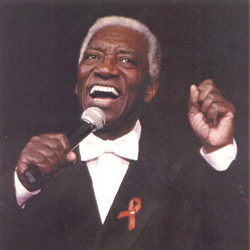On this edition of Riverwalk Jazz, the great jazz vocalist Joe Williams, a man whose name is practically synonymous with the blues, joins The Jim Cullum Jazz Band on stage at The Landing in a broadcast recorded live in 1994.
Early in his career Joe Williams performed in bands led by Erskine Tate, Coleman Hawkins and Lionel Hampton, before soaring to stardom with the Count Basie Band. In his lifetime, he received countless awards, and made numerous recordings and television appearances; shortly before his 1994 session at The Landing he released his album Here’s to Life on the Telarc label.
Over several years, Joe Williams played Bill Cosby’s father-in-law Grandpa Al Hanks on the hit television series The Cosby Show, and won a star on the Hollywood Walk of Fame. Known widely as “the best ballad singer in the world,” Joe Williams shares his music and his memories with our radio show audience.
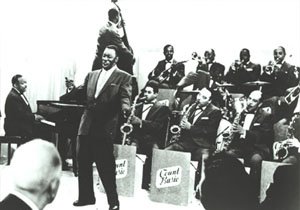
Joe Williams with the Count Basie Band. Photo courtesy Peter Chatman.
Joe Williams experienced the unusual phenomenon of winning international stardom virtually overnight in 1956. He was just settling in as the new singer with the Count Basie Band, and the very first recording he made with the group put Williams over the top. The story of “Every Day I Have the Blues” sounds like a fairytale. Out on the road when disc jockeys started playing it, the tune caught on like wildfire all over the country. Joe recalls, “What happened was, we recorded it in February, 1955. The fellow who had the record label was named Norman Granz, and he put it out in the summer, and it became a hit. Nobody ever put a record out in the summer back then, in July, because everybody’s away to country homes, or to the beach or somewhere. Well, he put it out in July, and by Christmas it was a big hit. The next year we made our first trip to Europe, and we were a big success.”
Born in the winter of 1918 in the small Georgia lumber town of Cordele, Joe Williams was christened Joseph Goreed. Later, at a kitchen table conference his family decided that “Williams” would make a better last name for an aspiring young singer. No one had encouraged Joe to sing as a young man; it was something he enjoyed doing. He recalls that after church services he’d hear the choral parts rolling around in his head, and could easily sing them all.

At age three, his mother took the family north to Chicago. In an apartment on the South Side of Chicago in the 1920s, Joe Williams discovered the magic of radio, and a whole new world opened up to him. Saturday afternoons he listened to live broadcasts of the Metropolitan Opera. He was mesmerized by the voice of announcer Milton J. Cross describing the golden curtain at the Met rising as the orchestra began to play the overture to La Boehme or Madame Butterfly. The radio also introduced him to artists like Paul Robeson and Marian Anderson, and to a group called “Four Boys and a Guitar” that later became famous as the Mills Brothers. There was always music in the apartment—if not on the radio, then with his mother or aunt at the piano.
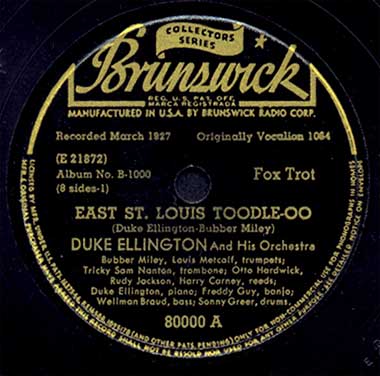
"East St. Louis Toodle-oo" label. Image courtesy ellingtonweb.ca
In high school Joe made sure to be home to catch a local radio show called Red Hot and Low Down. The theme song was Ellington’s “East St. Louis Toodle-oo,” and the broadcast featured music of Coleman Hawkins, Art Tatum, and Benny Carter. He heard the Duke Ellington Orchestra and Ethel Waters live from the Cotton Club in New York City, and listened to bandleader Earl Hines in broadcasts from Chicago’s glamorous Grand Terrace Ballroom from across town.
Influenced by the music he heard in church and on the radio, young Joe kept singing and developed a remarkable baritone voice with a high range. He began to sing at weddings and funerals and for church services with a quartet called the Jubilee Boys. At sixteen, he didn’t know whether singing could become a career, but he knew he was having fun. He netted a job with South Side bandleader Johnny Long. With Long’s orchestra, Joe sang popular songs like “Moonlight and Shadows” and “I Got Rhythm” for dances at clubs and ballrooms and sometimes skating rinks. In 1937 top jazz bandleader Jimmie Noone took Joe on as a soloist, and soon after he was singing with a sophisticated jazz orchestra led by Erskine Tate.
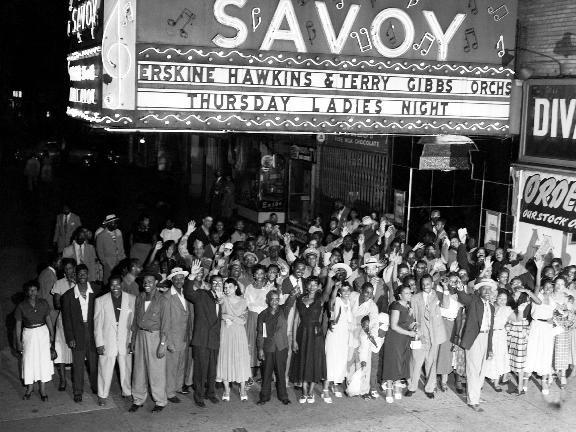
Savoy Ballroom photo courtesy dogpossom.org
Before long, Joe found himself a featured artist on national radio broadcasts on the CBS and NBC networks. He sang at the famous Savoy Ballroom, performed with the Les Hite band and joined Coleman Hawkins at Chicago’s elegant Café Society. He was 20 years old, and Joe Williams from Cordele, Georgia was on his way.
The late 30s and early 40s were exciting musical times in Chicago, and Joe Williams thrived on the scene. He toured with Lionel Hampton and appeared with the great Boogie Woogie team of Albert Ammons and Pete Johnson. Joe caught the attention of Andy Kirk, the popular bandleader from Kansas City. Kirk was knocked out when he heard Joe singing in a club in Chicago. He said, “I’ll always remember hearing Joe’s phrasing for the first time. He sang a line and then hummed; it was so beautiful I almost cried.”
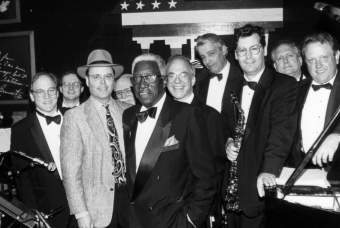
Joe Williams at The Landing with L to R, Jim Cullum, Mike Pittsley, David Holt, Joe, John Sheridan, Eddie Torres, Brian Ogilvie, Don Mopsick and Howard Elkins. Photo courtesy Riverwalk Jazz
On this broadcast, Joe Williams recalls the elegance of the club scene in those days. “I remember walking into a theater and seeing Duke Ellington on stage. The fellas were wearing white ties and tails, the costumes for the ladies were elegant, and the people in the audience were elegant as well. It was a genteel time for us in Chicago, and I loved every bit of it. It was nice to be a part of genteel elegance. I hope we never lose it.”
Traveling with Andy Kirk’s ensemble in 1947, the balladeer hit a low point in life. Joe Williams had a nervous breakdown and was hospitalized with depression for the better part of a year. Joe said, “It was like I stopped and everyone else went on.” In recovery, he became far more focused and serious about his career. Joe tells host David Holt that he realized how much his singing meant to others; people came up to him and told him his music had truly touched their lives. In 1949, back playing the Regal Theater; Williams first met George Shearing and Miles Davis. The next year, Joe performed with Count Basie’s septet and sang in popular South Side clubs, including the Club de Lisa on State Street.
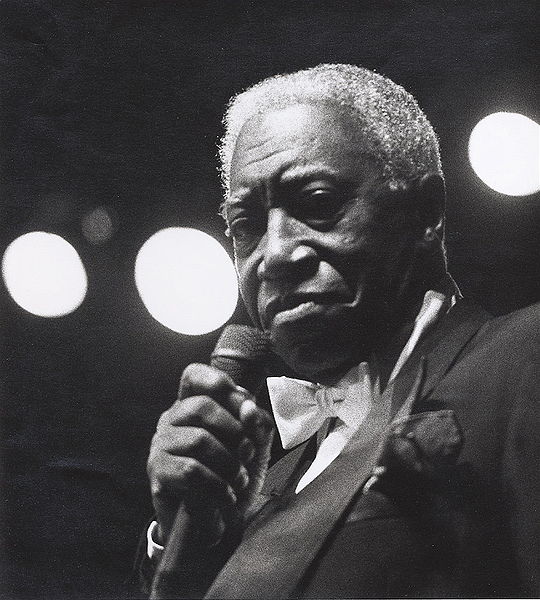
Joe Williams photo courtesy Wikimedia.
One night in 1950 Joe Williams was in the audience at the Brass Rail in Chicago where Count Basie was playing. Thrilled to see Joe at the club, Basie asked him to sing a number with the band, and they wound up performing several standards together that night. Before the evening was over, Basie asked Joe to show up at the club every night. Joe was to pretend he just happened to be in the neighborhood and sit at a table in the balcony. When Basie played the opening notes of “In My Solitude,” it would be Joe’s cue to come down to the stage as he began to sing the gorgeous ballad. This little bit of theater led to Joe Williams joining the Basie Band full time in 1954.
More about our radio show playlist:
“Swing '94” is an original instrumental “riff tune” by The Jim Cullum Jazz Band clarinetist Brian Ogilvie.
“Piano Man” is associated with the great pianist and bandleader Earl Hines, a leading figure in jazz in Chicago at the time Joe Williams came into his own there.
“Singin' In the Rain” is a popular standard Joe Williams sang with the Count Basie Orchestra when he first joined the group in the 1950s.
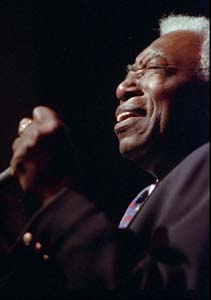
Joe Williams at The Landing. Photo courtesy Riverwalk Jazz
“Every Day I Have the Blues” and “All Right, Okay, You Win” are Joe Williams’ two biggest hit recordings with the Count Basie Orchestra.
“I Found A Million Dollar Baby” and “What a Wonderful World” are on Joe Williams’ 1994 Telarc CD Here’s to Life.
“(I’d Give a) Dollar For a Dime” is a classic number composed by Eubie Blake with a whimsical lyric by Andy Razaf. Joe Williams’ performance of the tune at a Kennedy Center concert honoring piano man Eubie Blake—then nearly 100 years old—was a highlight of Williams’ career. Williams recalls, “Everyone sort of misted over, including the fellows who were running the cameras. When we got through it, there was a moment of silence, then Eubie turned to a young lady in the booth where he was sitting and said, ‘Now that’s a pretty song. Did I write that?’”
“(I’d Rather Drink) Muddy Water” is a Chicago blues standard written by Eddie Miller; Joe Williams recorded an important cover.
Joe Williams includes the standard ballad “Tenderly” on our set list in tribute to Sarah Vaughan. “I first met her in 1943 in Washington DC when she was singing with Earl Hines’ Orchestra. Hines’ star vocalist Billie Eckstein told me, ‘They got a little girl singing with this band that’s about to sing me out of a job.’ I sing this number and think of her each time.”
On the subject of interpreting songs, Joe Williams says: “Songs are stories, little plays, vignettes. If you are able to tell the story convincingly, it’s good, it works.”
Photo credit for Home Page: Joe Williams photo courtesy xlyrics.de
Text based on Riverwalk Jazz script by Margaret Moos Pick ©1994


